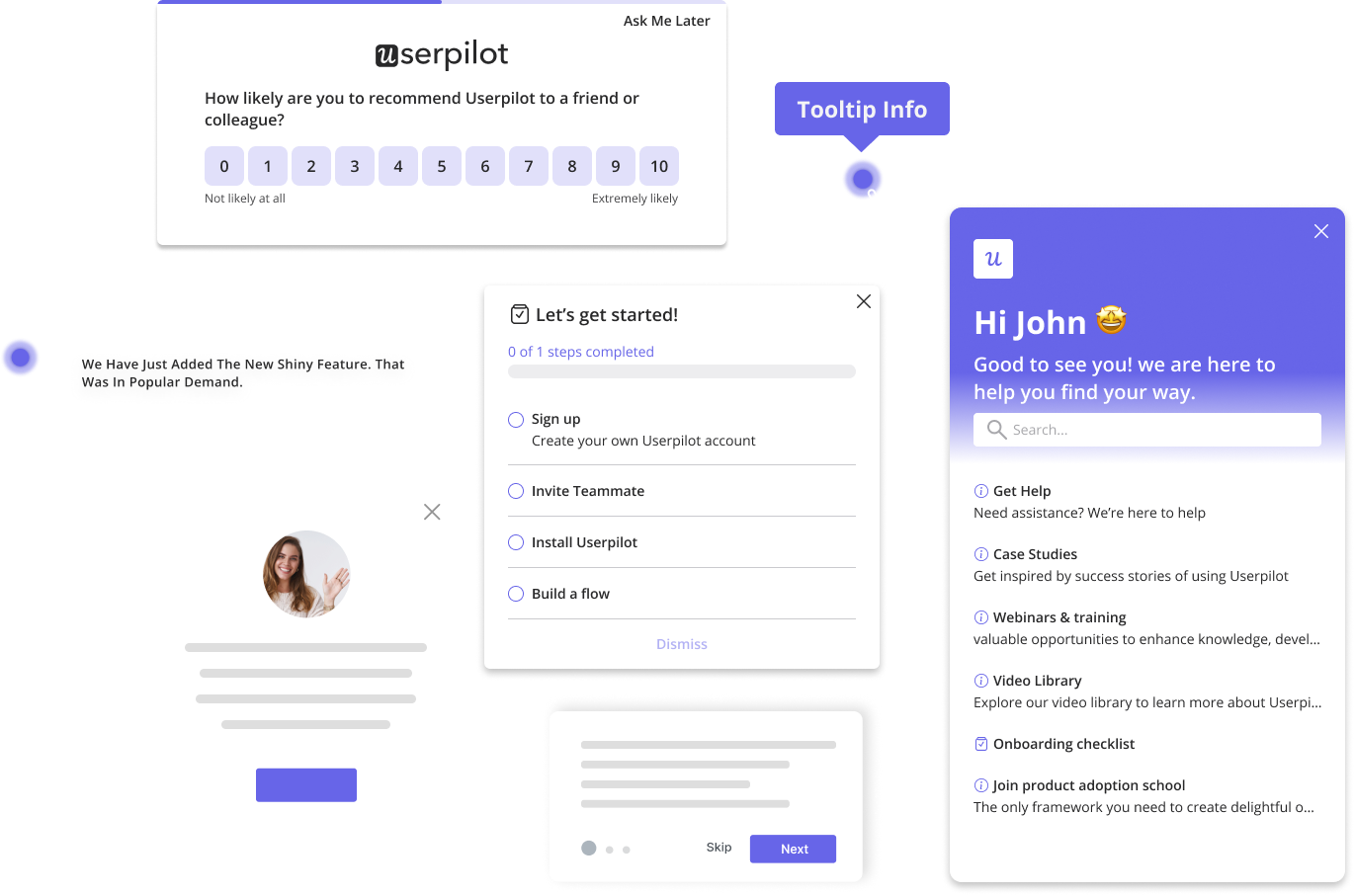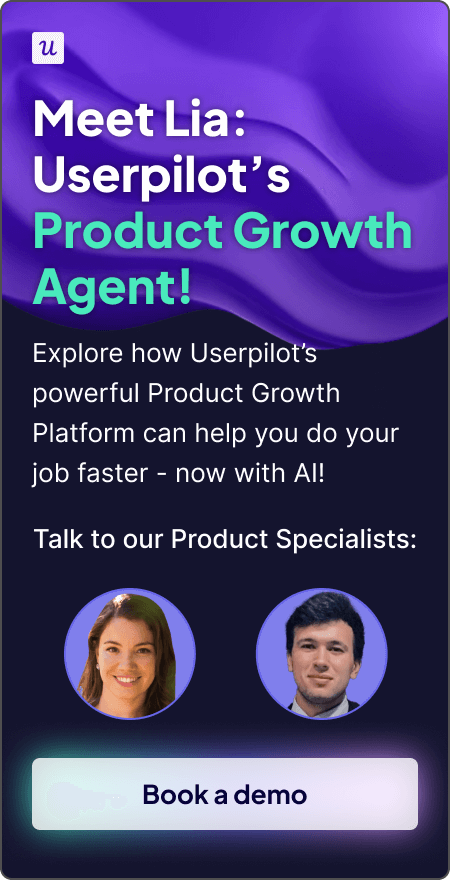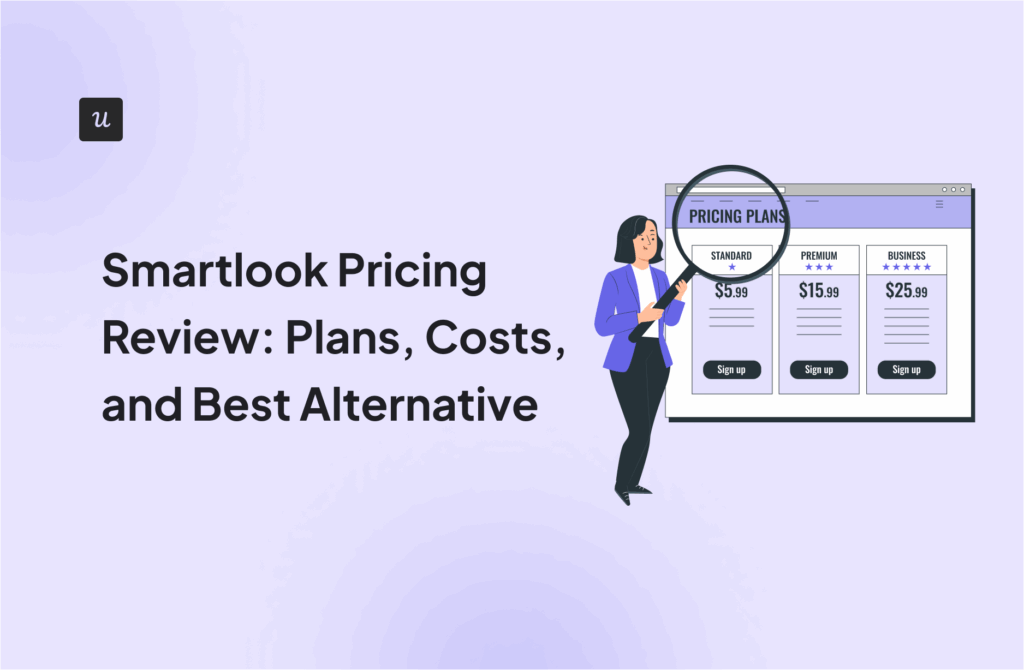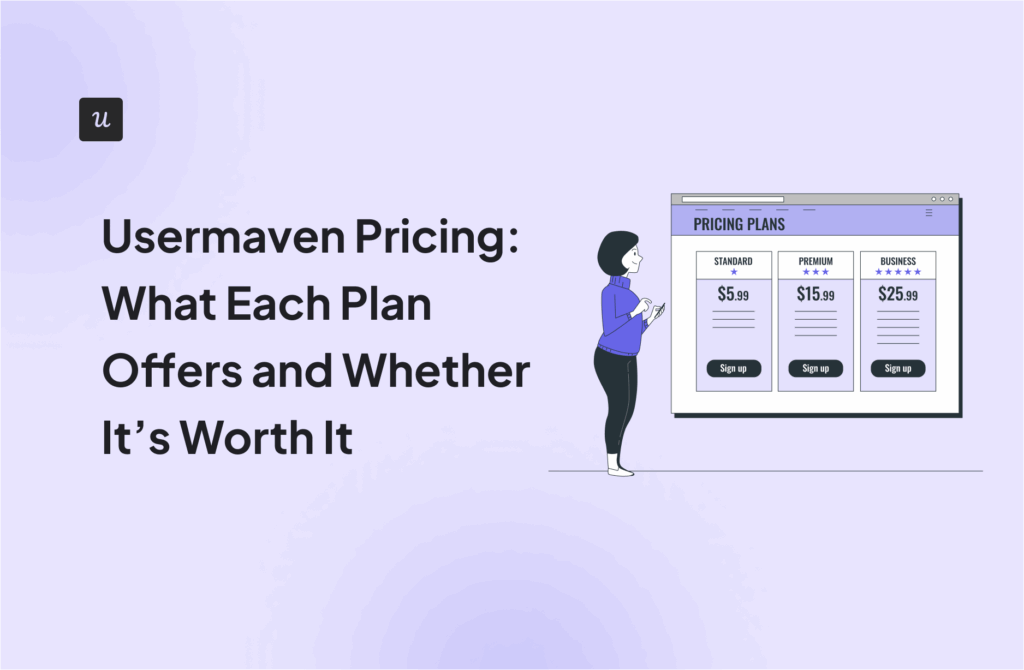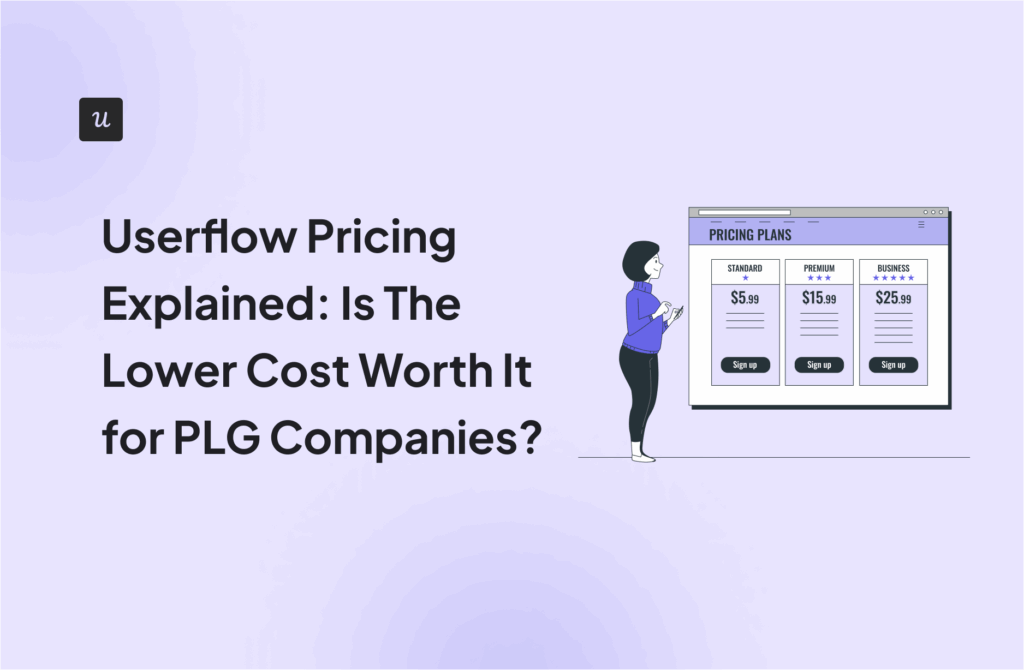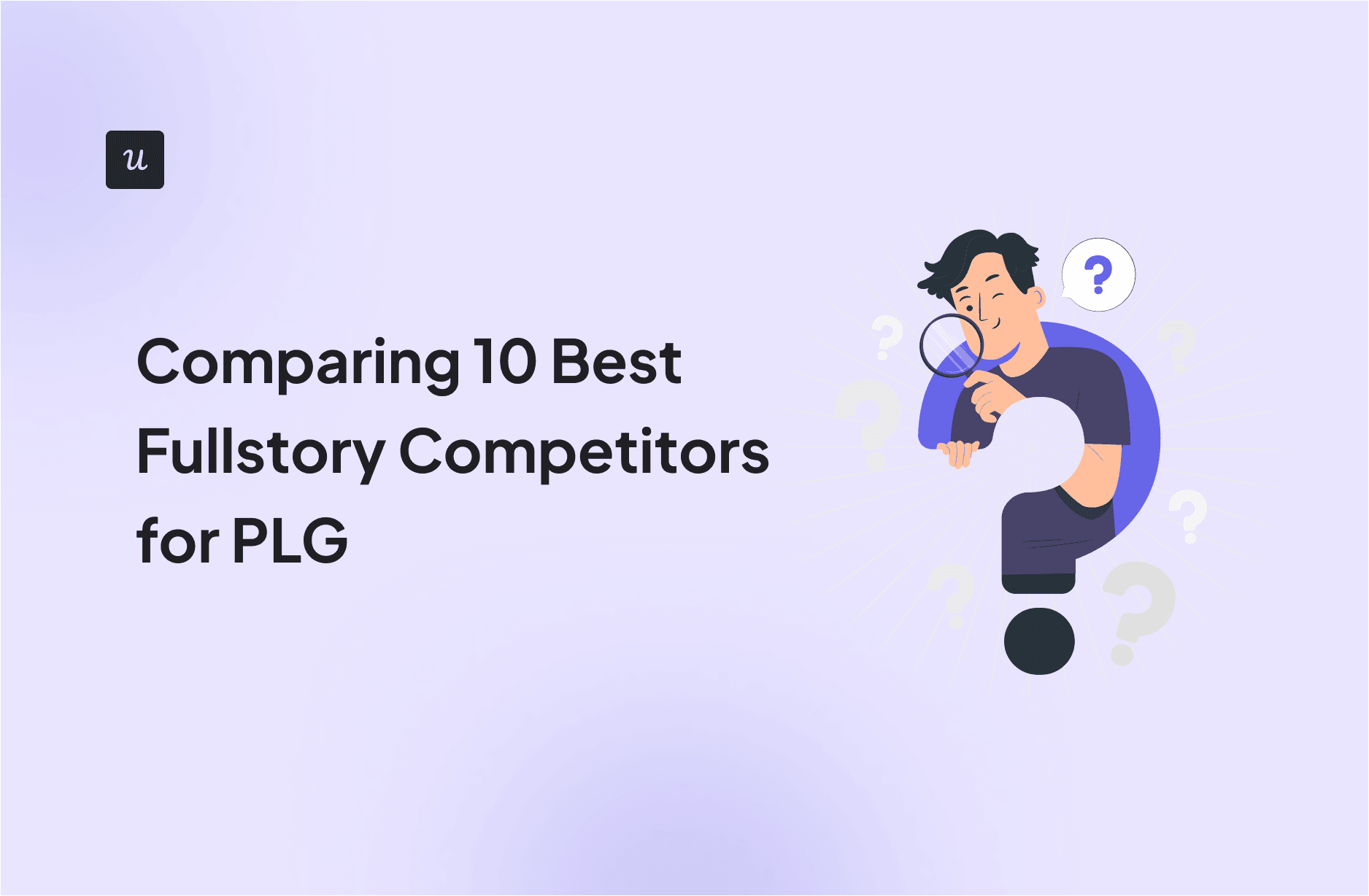
As a product marketing manager at a PLG company, I’ve tested more behavior analytics tools than I can count. I hear about Fullstory all the time, especially among teams looking for sleek visuals and advanced session replay tools. However, while its visual insights look good, it might not provide you with enough meaningful product analytics for PLG growth.
That’s not to say it’s a bad fit; it just depends on what your team needs. In this article, I’ll walk you through some of the best alternatives I’ve come across, each with its own strengths depending on what your PLG team is trying to solve.
What’s your biggest challenge with your current analytics tool?
Try Userpilot Now
See Why 1,000+ Teams Choose Userpilot
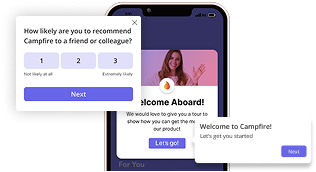
Pros and cons of Fullstory
When I first explored Fullstory, what stood out to me wasn’t just its visuals but how quickly I could get clarity by watching how users interact with our product in real time.
It’s not just another behavioral data platform trying to be everything. Fullstroy is really focused on showing you a complete picture of user behavior and finding friction fast.
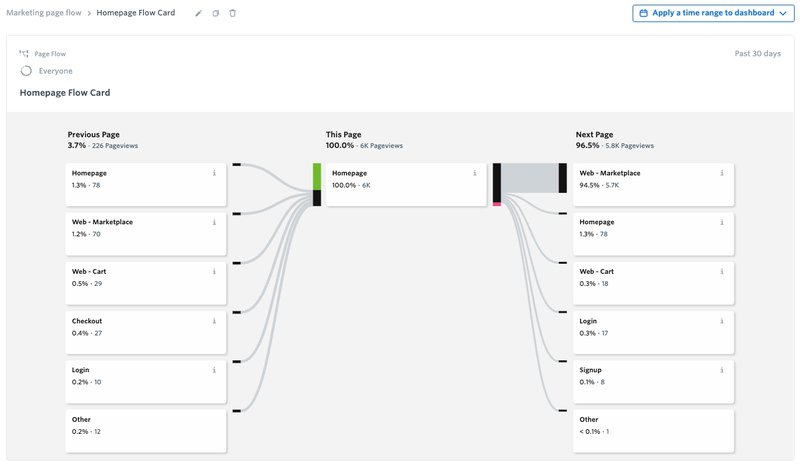
Here are the features I found most useful:
- High-fidelity session replays: Fullstory’s session replays are some of the best I’ve seen. They capture the full context of user behavior (clicks, scrolls, rage clicks, and more), all of which help you catch subtle UX issues that traditional analytics miss.
- Autocapture of user interactions: Every user action is captured by default, so you’re not blocked by tagging delays or engineering tickets. For fast-moving teams, that’s a big plus.
- Frustration signals (rage clicks, dead clicks, etc.): I love this built-in feature for finding hidden problems (like unresponsive buttons or dead-end flows) before they ever start impacting conversion.
- Heatmaps and click maps: Visual overlays help you see what’s getting attention and what’s being ignored. It’s a quick way to find content placement issues or confirm if users are engaging with key elements.
- Error tracking and console logs: Fullstory lets you drill into technical errors tied to specific sessions, which is great for bridging the gap between product and engineering.
- Segmented session search: You can filter recordings by traits like device type, errors, or user properties. It makes it easier to zoom in on specific patterns or cohorts.
✅ Pros of Fullstory
Now, here’s what I think makes Fullstory appealing for some PLG teams:
- The session replays are genuinely useful: I know everyone talks about them, but they are polished, rich in context and often the main reason teams try Fullstory in the first place.
- Rage clicks and frustration signals: One of my favorite features about the tool. It’s great for finding hidden UX problems and many tools don’t offer this level of precision.
- Autocapture + visuals together: Other tools do this too, but Fullstory pairs it with visual data, so you’re not just looking at numbers but also watching user behavior in real time.
- Session filters are super detailed: I could filter by device, country, console errors, and even click patterns. This kind of granularity is amazing.
- It connects product and support nicely: Not many analytics platforms actively cater to support teams, so Fullstory stands out there.
As one user on G2 shared:
Fullstory session replay is great and better than many alternatives we considered. We also find the segments, metrics, and funnels useful…All the features around replay are solid like redaction, note/share, heat map, etc. And it’s valuable to have a top-tier session replay tool integrated with product analytics.
❌ Cons of Fullstory
But like I mentioned before, here’s where Fullstory falls short, at least for teams that want more than just replays:
- Quantitative insights feel limited: You can watch sessions, but the core analytics features (like funnels, dashboards, and retention reports) are underwhelming. I found it hard to see the bigger picture at scale.
- No in-app guidance or engagement tools: Fullstory shows you where users struggle, but then what? It doesn’t help you act on that insight inside your product with tooltips, checklists, or nudges.
- Custom event tracking still needs dev support: Yes, there’s autocapture. But for anything beyond basic interactions, you’ll need to support custom event tracking. That slows teams down.
- Pricing ramps up fast: It’s usage-based, and without transparent pricing, it’s hard to plan costs. That unpredictability makes budgeting tricky for many teams.
- Performance issues with large-scale data: In my experience, once you’ve logged thousands of sessions, load times get sluggish.
- Not built for cross-functional activation: Fullstory helps you understand behavior, but it doesn’t support workflows across product, marketing, and customer success teams in a way that’s actionable. You’ll have to export data or rely on other tools for the next step.
Here’s how one user described their complaints with Fullstory:
I wasn’t able to get much value out of the metrics around user frustration or heatmaps and wasn’t able to leverage these reports towards A/B experimentation and feature testing. I found it most useful for debugging issues but would have liked to integrate the insights into more product optimization.
Pricing of Fullstory
I’ll be upfront about this: Fullstory is expensive.
According to Vendr, the median buyer pays around $28,245 per year, with actual pricing ranging anywhere from $9,600 to over $108,000 annually. That’s a huge spread, and unless you’re deep into the sales process, you won’t know where you land.
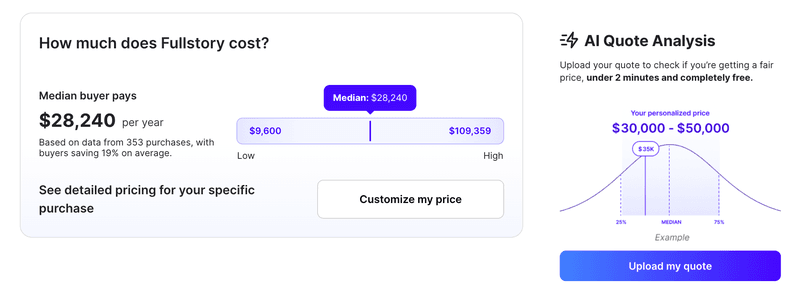
And I think for a tool that focuses only on analytics, that price tag can be hard to justify. Especially if you’re also paying for user onboarding, engagement, or experimentation tools on the side.
But what frustrated me the most was the lack of transparency. I couldn’t just go to their site, plug in my needs, and get a rough quote. Compare that to tools like Userpilot, where pricing is clear and scales with usage based on key metrics.
I think Fullstory might make sense for enterprise teams that rely heavily on session replays and behavioral tracking. But if you’re a growing product-led team and want flexibility and value, you’ll probably find a better fit elsewhere on this list.
Key considerations when evaluating analytics platforms
Before diving into specific tools, I defined what really mattered for our PLG strategy. It wasn’t just about tracking; it was about getting data-driven insights we could act on.
- Automatic vs. manual data capture: Some tools record every user interaction from the get-go (autocapture), while others require you to manually tag events. For me, the less heavy lifting, the better. I want to spend my time analyzing customer data, not setting up tracking. This is crucial for no-code analytics.
- Qualitative vs. quantitative insights: FullStory excels at the “what” (qualitative), but I needed tools that also answered the “how many” and “why” (quantitative). This blend is vital for understanding both individual user journeys and broader trends.
- Scalability and data governance: As our product grows, the sheer volume of behavioral data can become overwhelming. We need features that keep data clean and accessible for the whole team, without creating data silos.
- Ease of use and performance: A tool can have all the features in the world, but if it’s hard to use or slows down my browser, it won’t be adopted by the team. User experience matters for our internal tools, too.
- Pricing and value: It’s not just about the sticker price, but the ROI of the software. Does it deliver enough value to justify the investment, especially when aiming for value-based growth?
Top Fullstory competitors worth considering
Here’s a closer look at the platforms that frequently come up in conversations about Fullstory alternatives, and what I learned about each:
Userpilot
Of course, you’d expect me to say this. But truly, I’ve never seen a product analytics tool that feels this empowering for product teams, especially at the enterprise level.
Most tools either show you what’s happening or help you change it, but rarely both. That’s the core problem we set out to solve.
Userpilot gives product and growth teams a simple, no-code way to spot what’s blocking adoption, and then fix it fast. That means you’re not waiting on engineers or juggling a lot of tools. And because it works across both web and mobile, you’re not leaving gaps in your data or onboarding.
Here’s what I love most about it:
- Event autocapture that makes tagging optional, not mandatory: Userpilot automatically captures user interactions (like clicks, hovers, and screen views) so you’re not stuck waiting for instrumentation before you get any insight. We also support custom event tracking on top of autocaptured ones, so you can track any additional event on the server side of things.
- Funnels, user paths, retention, and trend reports: Instead of just showing raw numbers, these reports help you find out why, when, and where users drop off. For example, you can use path reports to see where new users go after onboarding, and adjust flows accordingly.
- Session replays add context to the numbers: One thing I (and many teams) love is how seamlessly you can jump from a report to a replay. It takes the guesswork out of data analysis and lets you validate patterns with actual behavior.
- Mobile app analytics that match your web stack: Most tools focus on web. With Userpilot, you can track events, flows, and screens across mobile apps too, and even launch in-app guidance natively. That’s a big differentiator for teams with a mobile-first audience.
- It’s analytics + action in one place: That’s the biggest difference, in my opinion. Most tools either show you behavior or help you change it. Userpilot does both. It lets you analyze what’s not working and fix it directly inside the product.
And it’s not just me saying this. At Amplemarket, their product managers rely on Userpilot session replays to monitor every new feature release. In their words:
“We release a lot of new features and improvements every week. Without a way to see what’s happening with the product, things simply break. Session replays are a huge lifesaver. Whenever a new feature is released, we watch 10–15 session replays to understand how it works. It made our product designers 80–90% more confident in developing new solutions.” -Awni Shamah, Staff Product Manager at Amplemarket
Every product team needs this kind of visibility and confidence. And that’s what we built Userpilot to deliver.
Userpilot pricing
At Userpilot, we offer three pricing tiers:
- Starter: Begins at $299/month for up to 2,000 MAUs and is generous in features, including segmentation, usage trends, plus user feedback and in-app engagement tools.
- Growth: Custom-priced and unlocks product analytics, retroactive autocapture, session replays, and mobile support (as an add-on).
- Enterprise: Custom-priced and includes advanced features like premium integrations, SAML/SSO, and priority support.
If you want to take it for a spin, you can sign up for a 14-day free trial, no credit card needed.
Heap

Heap is a strong contender that I seriously considered when looking at alternatives to Fullstory. Its main selling point is autocapture, which means it automatically records every click, swipe, and form submission without needing developers to tag events. This is huge for a PLG team, as it frees us up to focus on insights rather than setup.
What stood out to me most is that Heap offers integrated session replays and powerful data science features like Heap Illuminate, which help you pinpoint hidden friction points you might not have tagged manually.
It’s also well-suited for SaaS and enterprise companies, unlike FullStory’s B2C lean. If you want a comprehensive product analytics solution like Heap that captures everything and offers data science insights without heavy coding, it’s definitely one to explore.
Key features:
- Autocapture of every user action: Every interaction is recorded without manual tagging. That’s great if you want to start analyzing right away without engineering bottlenecks.
- Heap Illuminate (AI insights): It’s cool that Heap uses machine learning to find hidden friction in user journeys, and is perfect for finding issues you weren’t even looking for.
- Funnel, retention, and path analysis: Heap’s analytics suite is strong across the board and needs just minimal setup.
- Session replay (Pro plan and up): Not included by default, only available as an add-on. It’s helpful once you enable it, but the extra cost and setup might be a barrier.
- Strong data governance tools: I appreciate how Heap keeps event naming consistent and traceable across teams. That matters more than you think at scale.
My one gripe with Heap is that it doesn’t let you act on the insights directly. There are no in-app nudges or onboarding flows. So while the data analysis side is excellent, you’ll need a second tool to actually improve the experience inside your product.
I’d recommend Heap if what you want is a powerful, autocapture-first analytics platform with AI-powered insights. And only if you’re okay using another tool to act on that data.
Heap pricing
Heap offers four tiers:
- Free: With core analytics and up to 10,000 monthly sessions.
- Growth: Adds CSV exports, more users, and AI features, and is priced based on usage.
- Pro and Premier: Unlock advanced features like account analytics, engagement matrix, and session replays, but only as paid add-ons.
Exact pricing isn’t public, so you’ll need to contact sales to get a quote for anything beyond the Growth plan.
Amplitude
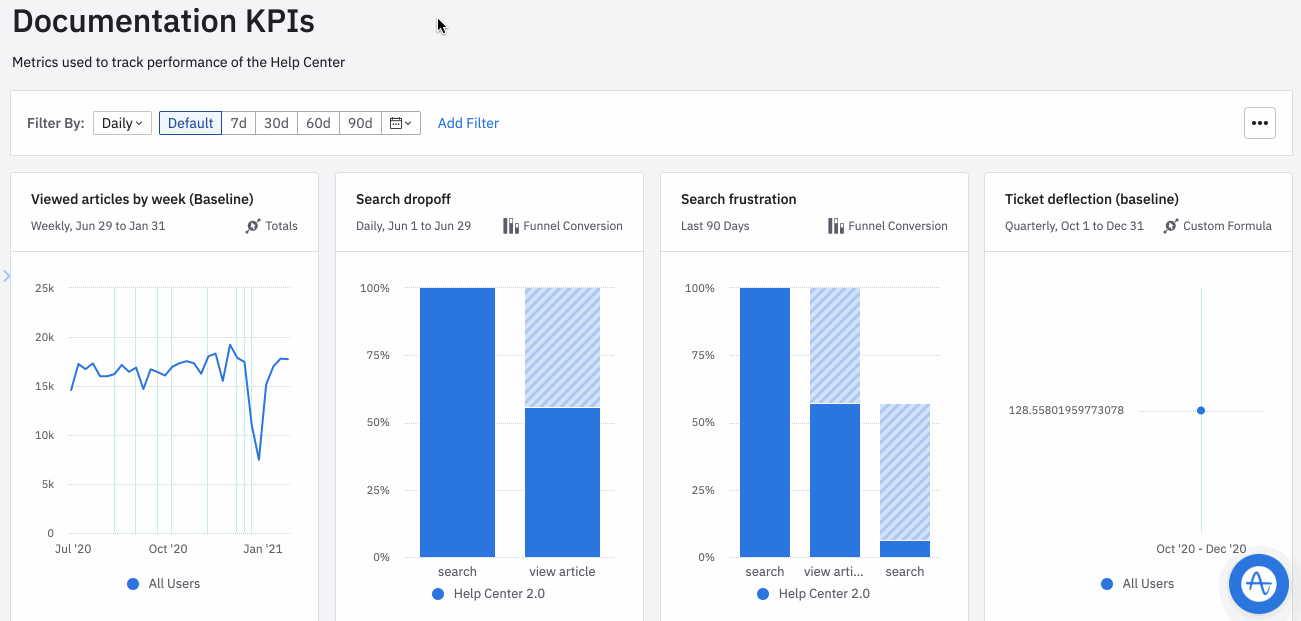
Amplitude is what I’d call a behavioral analytics powerhouse, often lauded by product teams with strong engineering resources. It’s fantastic for deep user analysis and can handle massive amounts of data.
However, I found that Amplitude requires a good deal of manual configuration to get going. That means you’ll have to dedicate engineering time to tag every event you want to track. Also, while it offers strong analytics, some users find it has a steep learning curve.
Key features:
- Advanced behavioral analytics: This is where Amplitude earns its reputation. You can build detailed funnels, look at conversion drivers, and track all the micro-interactions and paths users take through the product journey.
- Powerful cohorting and segmentation: I like that their behavioral cohorts feature lets you group users based on very specific patterns. Super useful for targeting and retention efforts.
- Feature flags and experimentation: Comes with built-in tools for A/B testing, though these often need technical setup.
- Session replay included even in free tier: A nice surprise. Although, they’re not as rich as what you’d get in a better digital insights platform like Fullstory or Userpilot.
- AI-powered analysis tools: There’s helpful automation here, like predictive audiences and automated insights. But they’re more useful once you’ve got your data tagged and flowing cleanly.
I think that if your team has the technical bandwidth to set up events manually and wants deep customization, Amplitude can be a solid choice. But for plug-and-play simplicity, it might not be the best fit.
Amplitude has a free Starter plan for up to 50K monthly tracked users and 10M events. It includes limited session replays, feature flags, and basic product and web analytics.
The Plus plan starts at $49/month and includes behavioral cohorts, segmentatio,n and online support.
For full-scale Growth or Enterprise plans, pricing is custom and will require you to contact sales.
Google Analytics (GA4)

I’ve used Google Analytics in nearly every role I’ve had. And I think that Google Analytics 4 (GA4) represents a big shift from its predecessors, moving towards an event-based model. It’s free, which is always a plus, and offers some predictive capabilities. GA4 provides high-level insights into website performance and customizable KPIs.
For smaller businesses or those already deeply embedded in the Google ecosystem, it can be perfectly fine. However, it’s not an easy upgrade. It’s a completely new architecture, requiring significant effort to re-tag events and preserve historical data.
For large-scale enterprises or e-commerce, the implementation costs and time can be substantial. Plus, my experience with free product support from Google isn’t always thrilling.
Key features:
- Event-based tracking architecture: I like that, unlike older versions of GA, GA4 tracks every interaction as an event. It gives you much more flexibility in how you define and measure behavior.
- Predictive analytics and basic AI insights: You can view churn probability and purchase likelihood, though you’ll need large aggregate data volumes for them to be reliable.
- Custom reports and dashboards: GA4 lets you build tailored KPIs and views, but the UI feels clunky compared to most tools.
- Built-in integrations with Google products: Its seamless syncing with Google Ads, Search Console, and BigQuery is nice if your team is already using them.
- Basic funnel and path exploration tools: It has basic user flow visualizations, but they lack the depth and usability of dedicated product analytics platforms like Amplitude or Userpilot.
Overall, I’d say it’s ideal only for startups, marketers, or website-focused teams looking for high-level insights on a budget. Especially if you’re already using Google Ads or Firebase.
Google Analytics pricing
GA4 is free by default, which makes it a popular starting point. But remember that while the tool is free, the time it takes to implement, maintain, and get value from it isn’t.
And if you need more data granularity, export options, or better SLAs, you might need Google Analytics 360, the enterprise version, which starts at $50,000/year.
Posthog
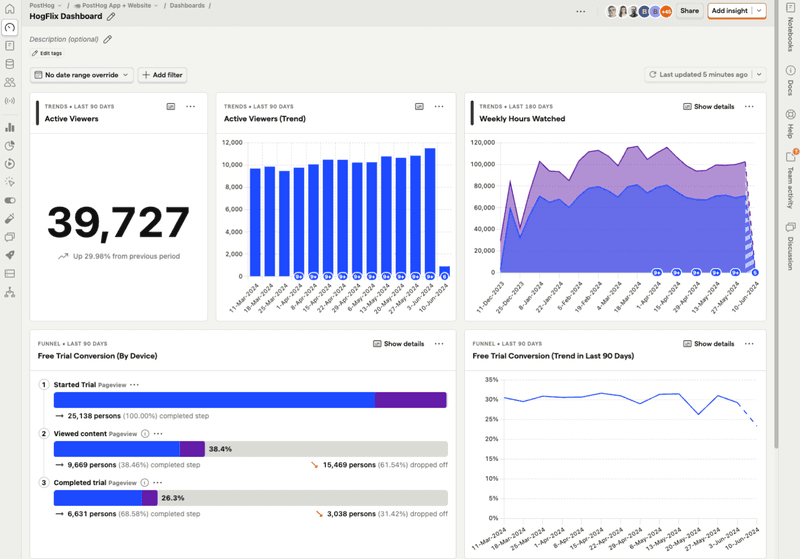
If you’re on a technical product team and want full control over your analytics stack, PostHog might be your thing.
Unlike most web analytics tools, PostHog gives you a whole toolbox in one place: from autocapture to feature flags to session replays. And because it’s open source at its core, it’s ideal for teams that want to self-host, customize or avoid vendor lock-in.
The tradeoff though, is that it’s not super no-code friendly. So if your team isn’t technical, getting the most out of PostHog might feel like a bit of a climb.
Key features:
- Autocapture for fast setup: PostHog starts tracking events automatically, which is a huge time-saver if you’re not looking to tag every click manually.
- Built-in session replay: You get a visual layer alongside your event data, which helps connect the “what” and “why” of user behavior. While I find it not as sleek as Fullstory, it’s solid and getting better.
- Feature flags and A/B testing: Lets you roll out features gradually, run experiments, and control releases, without needing a separate tool for that. Big plus for PLG teams shipping fast and iterating often.
- Surveys, paths, funnels, and more: Apart from basic analytics, PostHog includes native tools for building user journeys, tracking funnels, and even surveys.
- Everything in one place: Compared to tools like Fullstory or Mixpanel, which focus on just one layer (analytics or session replay), PostHog stands out for its breadth. It’s not as no-code as Userpilot, but if you’ve got the dev bandwidth, it’s powerful.
My recommendation: Posthog works best for teams that want to own their analytics stack end-to-end. Or PLG companies with in-house devs who’d rather build around one platform than stitch five together.
Posthog pricing
PostHog offers a generous free tier with 1M events, 5K session replays, 15K feature flag requests, and more, no credit card required. After that, it’s fully usage-based, with clear per-event pricing starting from $0.00006/event and $0.005/session replay.
Hotjar
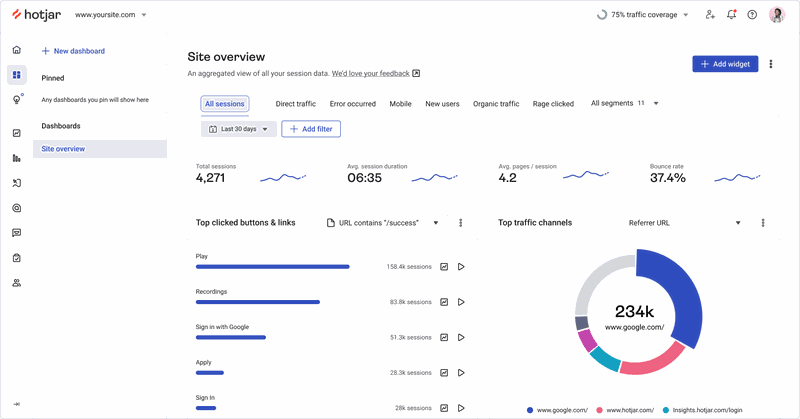
Hotjar has been around for a long time. And if you’ve ever searched for heatmaps or session recordings, you’ve probably landed on it at some point.
It’s not built for deep-dive product analytics, but it nails the basics if you want to understand how users navigate, where they click, and how far they scroll.
For PLG teams, I think it works best as a lightweight behavioral tool to surface friction points and collect user insights quickly. But when it comes to tracking adoption across journeys or getting granular with segments, you’ll hit the limits pretty quickly.
Key features:
- Heatmaps and session recordings: This is what Hotjar is best known for. You can see where users scroll, click, and hover. Super useful for fast website analytics and understanding how people are engaging with key pages or features.
- Surveys and feedback widgets: You can trigger in-app surveys to ask users what’s working (or not). It’s a simple but effective way to get qualitative data right in your product.
- User interviews and testing with Engage: This is one of their newer products, and honestly a cool addition. You can schedule real-time chats with users to validate ideas or dig into qualitative data.
- Frustration signals and behavior filters (on higher plans): You can filter recordings by rage clicks or low engagement, but those filters only unlock on higher tiers. Helpful, but limited compared to what we’ve built at Userpilot.
- Simple setup, low learning curve: Hotjar is super beginner-friendly. Most teams (especially marketers and designers) can get up and running without much help.
So, who would I recommend Hotjar to? Early-stage startups, marketing teams, or UX designers doing lightweight research. Basically, teams that want simple, visual insights into user behavior, but don’t need advanced analytics or in-app engagement.
Hotjar pricing
You can start using Hotjar for free, with up to 35 daily sessions on the Basic plan. From there, it jumps to $39/month for 100 daily sessions, and $99/month for the Business plan with frustration filters and behavior targeting.
Pricing depends on the modules you add, like Observe (heatmaps, replays), Ask (surveys), and Engage (interviews), so it scales based on what you need and your traffic volume.
LogRocket

LogRocket feels like it was built for engineers and product managers who work side by side. I like that it goes beyond basic session replays and combines performance data analytics, monitoring, and debugging in one tool.
You get access to JavaScript errors, console logs, network activity, and even performance slowdowns in the UI. It’s like having a dev console embedded in every session replay.
With that said, it’s more developer-centric than product-led. So if your team is less technical or looking for built-in engagement tools, LogRocket might feel too heavy.
Key features:
- Pixel-perfect session replays with full context: You can trace user sessions along with stack traces, console logs, and network requests. It’s a huge time-saver when you’re debugging edge cases or tracking regressions.
- Galileo AI for automatic struggle detection: This is one of the coolest bits. Their AI engine flags performance issues and behavioral friction automatically.
- Autocapture + conditional recording: You don’t need to tag every event manually (thankfully), and you can even set rules to capture only specific sessions.
- Detailed product analytics: You get funnel analysis, conversion charts, paths, and heatmaps. Not as flexible as a tool like Userpilot, but still solid for most product use cases.
- Developer-first features: I think what really makes LogRocket unique is how closely it ties into dev workflows. You can tie sessions to bugs, monitor performance over time, and feed insights straight into your dev team’s workflow.
LogRocket is definitely a better fit for teams that have a strong product-engineering collaboration. Especially if debugging, QA, or performance monitoring is a big part of your day-to-day.
LogRocket pricing
LogRocket’s Free plan gives you 1,000 sessions/month with 1-month data retention.
The Team plan starts at $69/month, while the Professional plan jumps to $295–$350/month with access to Galileo AI and more advanced analytics. Enterprise plans are custom, with features like conditional recording, self-hosting, and unlimited sessions.
Smartlook
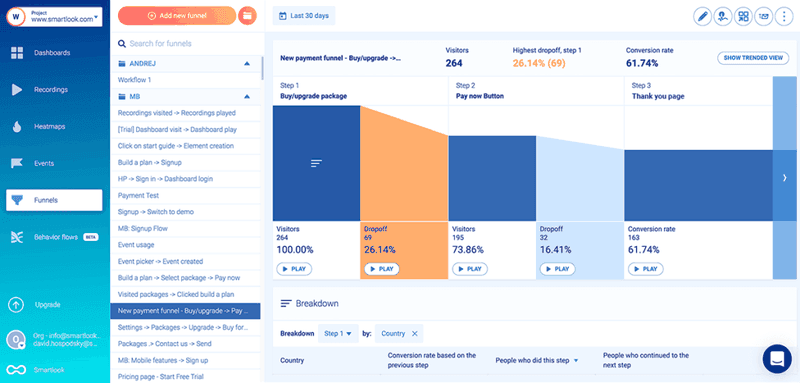
If you’re after a session replay and analytics tool that works well out of the box, but also lets you scale up later, Smartlook is a pretty underrated option.
It gives you a nice balance between behavior analytics, session recordings, and event-based tracking, without being overwhelming. Also, it covers core mobile app analytics if you’re building across platforms. I especially like it for early-stage product teams that want to move beyond heatmaps but aren’t ready for the setup demands of something like Mixpanel or Amplitude.
Also, if you’re running both web and mobile apps, Smartlook supports both platforms with the same plan, which is nice.
Key features:
- Session recordings with filters that actually help: You can filter by things like user type or event name, and replay sessions based on specific actions. Helps you find friction without watching hundreds of videos.
- Heatmaps + historical data: Smartlook includes heatmaps in all plans, and the paid tiers unlock longer data retention and better resolution. It’s not as advanced as Fullstory’s frustration tracking, but still very usable.
- Product analytics without the bloat: You get funnels, events, and retention reports, plus anomaly detection on higher plans. It’s not as deep as something like Mixpanel, but you also don’t need an analyst to use it.
- Add-ons for dev teams: Tools like DevTools, detailed error tracking, and API integrations are available on higher plans. I’d say it’s somewhere between LogRocket and Hotjar in terms of how technical it gets.
- Web and mobile application support: Smartlook works across both platforms, which is still oddly rare.
Of course, the one thing Smartlook is missing is that it doesn’t offer any in-app guidance or engagement features like Userpilot. So it’s more about observing and understanding, not prompting users or guiding them through friction. But if you’re a product team that wants session replay + basic product analytics in one tool, without overpaying or overcomplicating their setup, Smartlook is a good choice.
Smartlook pricing
Smartlook has three plans:
- Free plan: 3,000 monthly sessions, heatmaps, and basic analytics.
- Pro plan: Starts at $55/month, with 5,000+ sessions, anomaly detection, CSV export, and premium integrations.
- Enterprise plan: Custom-priced, with options like single sign-on, REST API access, and data export.
You can also pick add-ons like unlimited heatmaps, extended data retention, and DevTools.
Mixpanel

Mixpanel is another strong analytics platform that tracks user behavior across devices. It excels at measuring how users navigate digital products and is particularly useful for analyzing large volumes of microtransactions, which could be great for specific campaign metrics.
Similar to Amplitude, Mixpanel relies heavily on manual event configuration, which means you’re investing precious engineering resources to set it up properly. Also, while it offers powerful behavioral analytics and dashboards, users sometimes report that its visualization and customization capabilities are limited.
If your core need is campaign tracking and you have the engineering talent to invest in setup, Mixpanel could work, but it doesn’t solve the labor-intensive event tracking problem for general use.
Key features:
- Powerful event-based tracking: Capture every click, swipe, or interaction and break it down by cohort, segment, or product version. It’s great when you need specific answers, not just surface metrics.
- Retention and funnel insights: You can break down drop-offs by user group or product changes. Much stronger than the lightweight reports in tools like Hotjar or Smartlook.
- Self-serve dashboards: Once it’s set up, even non-technical teams can explore data and build reports, which makes insights more accessible across product and marketing.
- AI-powered query builder (Spark): Ask questions in plain language and get instant results. Super helpful if you’re not working with a dedicated data analyst.
- Clean UI and fast performance: Mixpanel’s UX is actually enjoyable, and everything feels smooth and fast, even with large datasets.
If your product team is data-savvy and you’ve got the resources to support detailed event tracking, Mixpanel can offer detailed insights that are hard to beat. But it’s definitely not a plug-and-play solution. For teams looking for a lighter setup or more out-of-the-box insights, you might want to look elsewhere.
Mixpanel’s pricing includes three plans:
- Free: Up to 1 million monthly events, 5 saved reports per seat, and 10K monthly session replays.
- Growth: Starts at $0, but charges $0.28 per 1K events after the first million. Comes with unlimited reports, 20K replays/month, cohorts, templates, and Spark AI queries (60/month).
- Enterprise: Custom pricing, with 1T+ monthly events, advanced governance, and 300 Spark queries/month.
Pendo
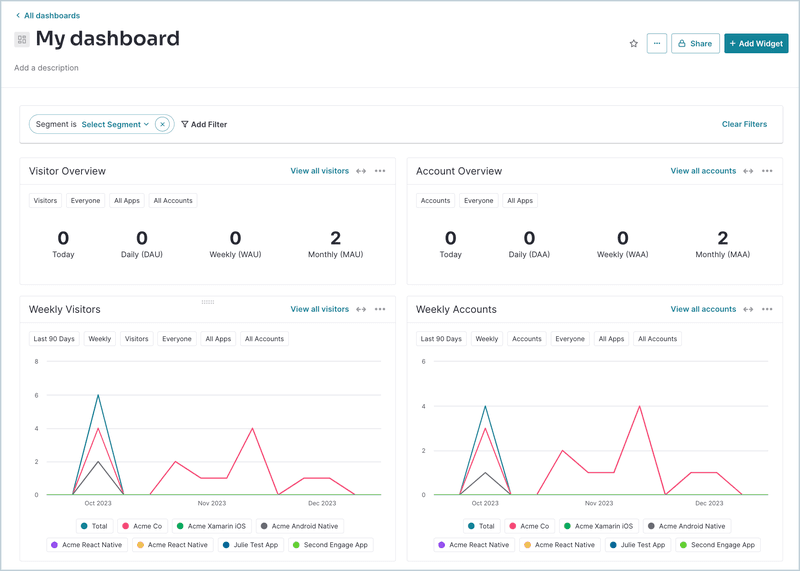
I find that Pendo often gets grouped with FullStory because it focuses heavily on product adoption and user onboarding. But as a digital insights platform, it has its own merits. It offers a decent look into how users engage with your software and is good for building in-app guides and understanding conversion funnels.
However, when it comes to robust analytical capabilities for deep user engagement or user-by-user segmentation, Pendo can fall short. While it has some autocapture, you’ll still need to manually tag many events to capture what truly matters to your business.
Key features:
- In-app guides and onboarding flows: Pendo shines here. You can build tooltips, walkthroughs, and product tours without needing to code. It’s similar to Userpilot in that way, though Userpilot gives you more styling control out of the box.
- Product analytics with event tagging: You get usage reports, pathing, funnels, and retention, but it’s not as flexible or detailed as Mixpanel.
- Net Promoter Score (NPS) surveys: Pendo has native NPS tracking, which makes it easy to gather user sentiment inside the product. It’s handy if you’re just starting out with feedback loops.
- Supports web and mobile (but limited): It works across both platforms, but Pendo’s session replay is web-only and locked behind higher-tier plans.
- AI-powered session insights (on higher tiers): You get AI-suggested replays and frustration detection, but only if you’re on Pulse or above. This brings it a bit closer to Fullstory, but it’s not the default experience.
If your main goal is to drive feature adoption and guide users with product tours, Pendo is a decent option, but if you need comprehensive product analytics software to dig into the “why” behind user actions, you might find it limited.
Pendo offers four paid plans and one free tier:
- Free: Up to 500 monthly active users, with basic analytics, in-app guides, NPS, and roadmaps.
- Base plan (request pricing): Custom MAU, product analytics, in-app guides, and one integration.
- Core plan (request pricing): Includes everything in Base, plus session replays.
- Pulse plan (request pricing): Adds NPS tools and product discovery features on top of Core.
- Ultimate plan (request pricing): Includes all features, plus advanced in-app guides, journey orchestration, and data sync.
Most of the good stuff (like replays and AI insights) only unlocks on higher plans, and pricing is gated behind sales calls. That can be frustrating if you’re comparing options or trying to budget quickly.
Making the right choice for your product
So, compared to Fullstory, what’s the best tool out there? Of course, there’s no one right answer. It all comes down to what you’re solving for: Better user behavior analytics? More user engagement? A smoother user experience?
But I’ll say this: if you want actionable insights, support for custom event tracking and a way to analyze user behavior across both web and mobile applications, Userpilot is the tool that does it all. It does way, way more than just replaying user sessions, and was built to actually keep users coming back.
Book a Userpilot demo to see how it stacks up against other Fullstory competitors, and see how it can help your customer success team turn user interactions into real growth.

